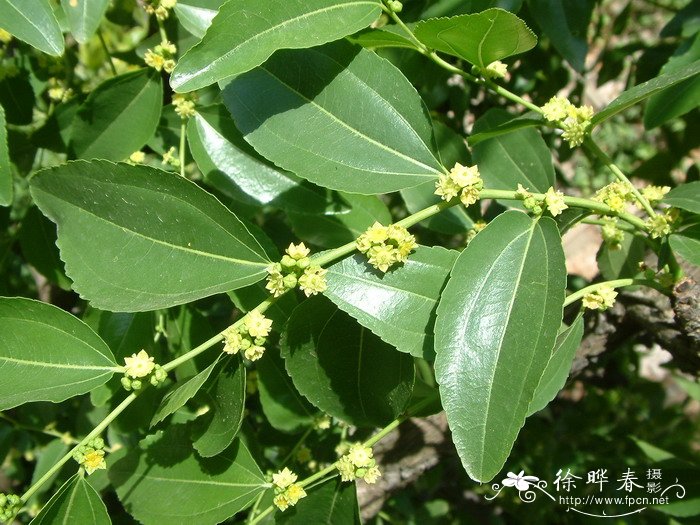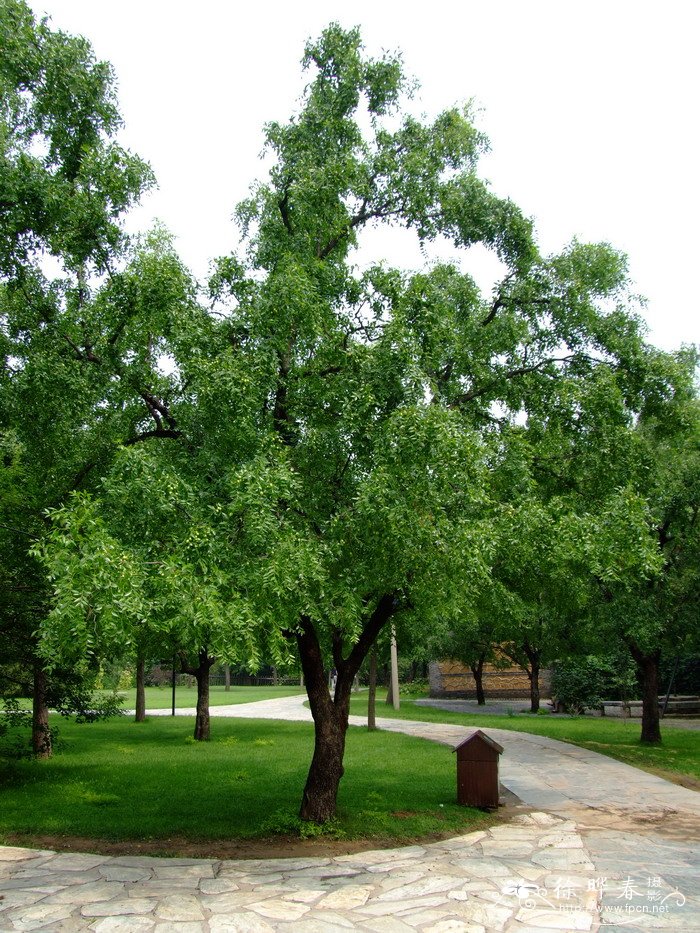枣Ziziphus jujuba
中文名(Chinese Name):枣
学名(Scientific Name):Ziziphus jujuba Mill.
英文名(English Common Name):
别名(Chinese Common Name):枣子、红枣
异名(Synonym):Rhamnus soporifera Lour. Rhamnus zizyphus L. Ziziphus nitida Roxb. Ziziphus orthacantha DC. Ziziphus poiretii G.Don Ziziphus rotundata DC. Ziziphus soporifera (Lour.) Stokes Ziziphus tomentosa Poir. Ziziphus trinervia Roth Zizyphon jujubum St.-Lag.
科属(Family & Genus):鼠李科(Rhamnaceae)枣属
形态特征(Description):落叶小乔木,稀灌木,高达10余米;树皮褐色或灰褐色;有长枝,短枝和无芽小枝(即新枝)比长枝光滑,紫红色或灰褐色,呈之字形曲折,具2个托叶刺,长刺可达3厘米,粗直,短刺下弯,长4-6毫米;短枝短粗,矩状,自老枝发出;当年生小枝绿色,下垂,单生或2-7个簇生于短枝上。叶纸质,卵形,卵状椭圆形,或卵状矩圆形;长3-7厘米,宽1.5-4厘米,顶端钝或圆形,稀锐尖,具小尖头,基部稍不对称,近圆形,边缘具圆齿状锯齿,上面深绿色,无毛,下面浅绿色,无毛或仅沿脉多少被疏微毛,基生三出脉;叶柄长1-6毫米,或在长枝上的可达1厘米,无毛或有疏微毛;托叶刺纤细,后期常脱落。花黄绿色,两性,5基数,无毛,具短总花梗,单生或2-8个密集成腋生聚伞花序;花梗长2-3毫米;萼片卵状三角形;花瓣倒卵圆形,基部有爪,与雄蕊等长;花盘厚,肉质,圆形,5裂;子房下部藏于花盘内,与花盘合生,2室,每室有1胚珠,花柱2半裂。核果矩圆形或长卵圆形,长2-3.5厘米,直径1.5-2厘米,成熟时红色,后变红紫色,中果皮肉质,厚,味甜,核顶端锐尖,基部锐尖或钝,2室,具1或2种子,果梗长2-5毫米;种子扁椭圆形,长约1厘米,宽8毫米。花期5-7月,果期8-9月。
分布(Distribution):产我国大部分省区,生长于海拔1700米以下的山区、丘陵或平原。广为栽培。
用途(Use):枣的果实味甜,含有丰富的维生素C、P,除供鲜食外,常可以制成蜜枣、红枣、熏枣、黑枣、酒枣及牙枣等蜜饯和果脯,还可以作枣泥、枣面、枣酒、枣醋等,为食品工业原料。枣又供药用,有养胃、健脾、益血、滋补、强身之效,枣仁和根均可入药,枣仁可以安神,为重要药品之一。枣树花期较长,芳香多蜜,为良好的蜜源植物。
引自中国植物志英文版:FOC Vol. 12 Page 115, 120, 122
Ziziphus jujuba Miller, Gard. Dict., ed. 8. Ziziphus no. 1. 1768.
枣 zao | Rhamnaceae | Ziziphus
Trees small, rarely shrubs, deciduous, to 10 m tall, spinose or unarmed. Bark brown or gray-brown, with long reduced branches, without buds; branchlets (new branches) purple-red or gray-brown, flexuose, smooth, with 2 stipular spines or not; long spines erect, to 3 cm, stout; short spines recurved, developed from old branches; annual branchlets pendulous, green, solitary or 2-7-fascicled on short shoots. Stipular spines slender, caducous; petiole 1-6 mm, or to 1 cm on long shoots, glabrous or sparsely puberulent; leaf blade abaxially pale green, adaxially dark green, ovate, ovate-elliptic, or elliptic-oblong, 3-7 × 1.5-4 cm, papery, abaxially ± puberulent on major veins or glabrous, adaxially glabrous, 3-veined from base, base slightly asymmetric, subrounded, margin crenate-serrate, apex obtuse or rounded, rarely acute, mucronulate. Flowers yellow-green, bisexual, 5-merous, glabrous, solitary or 2-8 crowded in axillary cymes, shortly pedunculate. Pedicel 2-3 mm. Sepals ovate-triangular, adaxially distinctly keeled. Petals obovate, ca. as long as stamens, clawed at base. Disk orbicular, thick, fleshy, 5-lobed. Ovary basally slightly immersed in disk; style 2-cleft to half. Drupe red at maturity, turning red-purple, oblong or narrowly ovoid, 2-3.5 cm, (0.5-)1.5-2 cm in diam.; mesocarp fleshy, thick, sweet- or sour-tasting; stone acute or obtuse at both ends, 2-loculed, 1- or 2-seeded; fruiting pedicel 2-5 mm or longer. Seeds compressed-orbicular, ca. 1 × 0.8 cm, Fl. May-Jul, fr. Aug-Oct. 2n = 24*, 36*, 48*.
● Mountains, hills, sunny dry slopes, plains, also widely cultivated; below 1700 m. Anhui, Fujian, Gansu, Guangdong, Guangxi, Guizhou, Hebei, Henan, Hubei, Hunan, Jiangsu, Jiangxi, Jilin, Liaoning, Nei Mongol, Ningxia, Shaanxi, Shandong, Shanxi, Sichuan, Xinjiang, Yunnan, Zhejiang [cultivated in Africa, Asia, Europe, and North and South America].
Kirkbride et al. (Taxon 55: 1049-1050. 2007 ["2006"]) proposed the name Ziziphus jujuba for conservation against the paratautonym Z. zizyphus.
Ziziphus jujuba f. tortuosa C. Y. Cheng & M. J. Liu (J. Hebei Agric. Univ. 17(4): 7. 1994) is cultivated in gardens in Hebei, Henan, Jiangsu, S Shaanxi (Qin Ling), and Shandong. The plants are small trees with ascending, often tortuous branchlets without spines, long fruiting pedicels, and small drupes ca. 5 mm in diam. that resemble cucurbit fruits.
Ziziphus jujuba f. lageniformis (Nakai) Kitagawa (Lin. Fl. Manshur. 313. 1939; Z. sativa Gaertner var. lageniformis Nakai, Rep. Exped. Manchoukuo, Sect. IV, 1: 8. 1934) was recorded in FRPS (48(1): 136. 1982) from Hebei and (as cultivated) Beijing. However, it could not be treated here because no material was seen by the authors.


 (责任编辑:徐晔春)
(责任编辑:徐晔春)
学名(Scientific Name):Ziziphus jujuba Mill.
英文名(English Common Name):
别名(Chinese Common Name):枣子、红枣
异名(Synonym):Rhamnus soporifera Lour. Rhamnus zizyphus L. Ziziphus nitida Roxb. Ziziphus orthacantha DC. Ziziphus poiretii G.Don Ziziphus rotundata DC. Ziziphus soporifera (Lour.) Stokes Ziziphus tomentosa Poir. Ziziphus trinervia Roth Zizyphon jujubum St.-Lag.
科属(Family & Genus):鼠李科(Rhamnaceae)枣属
形态特征(Description):落叶小乔木,稀灌木,高达10余米;树皮褐色或灰褐色;有长枝,短枝和无芽小枝(即新枝)比长枝光滑,紫红色或灰褐色,呈之字形曲折,具2个托叶刺,长刺可达3厘米,粗直,短刺下弯,长4-6毫米;短枝短粗,矩状,自老枝发出;当年生小枝绿色,下垂,单生或2-7个簇生于短枝上。叶纸质,卵形,卵状椭圆形,或卵状矩圆形;长3-7厘米,宽1.5-4厘米,顶端钝或圆形,稀锐尖,具小尖头,基部稍不对称,近圆形,边缘具圆齿状锯齿,上面深绿色,无毛,下面浅绿色,无毛或仅沿脉多少被疏微毛,基生三出脉;叶柄长1-6毫米,或在长枝上的可达1厘米,无毛或有疏微毛;托叶刺纤细,后期常脱落。花黄绿色,两性,5基数,无毛,具短总花梗,单生或2-8个密集成腋生聚伞花序;花梗长2-3毫米;萼片卵状三角形;花瓣倒卵圆形,基部有爪,与雄蕊等长;花盘厚,肉质,圆形,5裂;子房下部藏于花盘内,与花盘合生,2室,每室有1胚珠,花柱2半裂。核果矩圆形或长卵圆形,长2-3.5厘米,直径1.5-2厘米,成熟时红色,后变红紫色,中果皮肉质,厚,味甜,核顶端锐尖,基部锐尖或钝,2室,具1或2种子,果梗长2-5毫米;种子扁椭圆形,长约1厘米,宽8毫米。花期5-7月,果期8-9月。
分布(Distribution):产我国大部分省区,生长于海拔1700米以下的山区、丘陵或平原。广为栽培。
用途(Use):枣的果实味甜,含有丰富的维生素C、P,除供鲜食外,常可以制成蜜枣、红枣、熏枣、黑枣、酒枣及牙枣等蜜饯和果脯,还可以作枣泥、枣面、枣酒、枣醋等,为食品工业原料。枣又供药用,有养胃、健脾、益血、滋补、强身之效,枣仁和根均可入药,枣仁可以安神,为重要药品之一。枣树花期较长,芳香多蜜,为良好的蜜源植物。
引自中国植物志英文版:FOC Vol. 12 Page 115, 120, 122
Ziziphus jujuba Miller, Gard. Dict., ed. 8. Ziziphus no. 1. 1768.
枣 zao | Rhamnaceae | Ziziphus
Trees small, rarely shrubs, deciduous, to 10 m tall, spinose or unarmed. Bark brown or gray-brown, with long reduced branches, without buds; branchlets (new branches) purple-red or gray-brown, flexuose, smooth, with 2 stipular spines or not; long spines erect, to 3 cm, stout; short spines recurved, developed from old branches; annual branchlets pendulous, green, solitary or 2-7-fascicled on short shoots. Stipular spines slender, caducous; petiole 1-6 mm, or to 1 cm on long shoots, glabrous or sparsely puberulent; leaf blade abaxially pale green, adaxially dark green, ovate, ovate-elliptic, or elliptic-oblong, 3-7 × 1.5-4 cm, papery, abaxially ± puberulent on major veins or glabrous, adaxially glabrous, 3-veined from base, base slightly asymmetric, subrounded, margin crenate-serrate, apex obtuse or rounded, rarely acute, mucronulate. Flowers yellow-green, bisexual, 5-merous, glabrous, solitary or 2-8 crowded in axillary cymes, shortly pedunculate. Pedicel 2-3 mm. Sepals ovate-triangular, adaxially distinctly keeled. Petals obovate, ca. as long as stamens, clawed at base. Disk orbicular, thick, fleshy, 5-lobed. Ovary basally slightly immersed in disk; style 2-cleft to half. Drupe red at maturity, turning red-purple, oblong or narrowly ovoid, 2-3.5 cm, (0.5-)1.5-2 cm in diam.; mesocarp fleshy, thick, sweet- or sour-tasting; stone acute or obtuse at both ends, 2-loculed, 1- or 2-seeded; fruiting pedicel 2-5 mm or longer. Seeds compressed-orbicular, ca. 1 × 0.8 cm, Fl. May-Jul, fr. Aug-Oct. 2n = 24*, 36*, 48*.
● Mountains, hills, sunny dry slopes, plains, also widely cultivated; below 1700 m. Anhui, Fujian, Gansu, Guangdong, Guangxi, Guizhou, Hebei, Henan, Hubei, Hunan, Jiangsu, Jiangxi, Jilin, Liaoning, Nei Mongol, Ningxia, Shaanxi, Shandong, Shanxi, Sichuan, Xinjiang, Yunnan, Zhejiang [cultivated in Africa, Asia, Europe, and North and South America].
Kirkbride et al. (Taxon 55: 1049-1050. 2007 ["2006"]) proposed the name Ziziphus jujuba for conservation against the paratautonym Z. zizyphus.
Ziziphus jujuba f. tortuosa C. Y. Cheng & M. J. Liu (J. Hebei Agric. Univ. 17(4): 7. 1994) is cultivated in gardens in Hebei, Henan, Jiangsu, S Shaanxi (Qin Ling), and Shandong. The plants are small trees with ascending, often tortuous branchlets without spines, long fruiting pedicels, and small drupes ca. 5 mm in diam. that resemble cucurbit fruits.
Ziziphus jujuba f. lageniformis (Nakai) Kitagawa (Lin. Fl. Manshur. 313. 1939; Z. sativa Gaertner var. lageniformis Nakai, Rep. Exped. Manchoukuo, Sect. IV, 1: 8. 1934) was recorded in FRPS (48(1): 136. 1982) from Hebei and (as cultivated) Beijing. However, it could not be treated here because no material was seen by the authors.
踩一下[0]

顶一下[4]